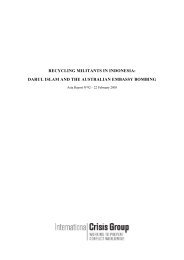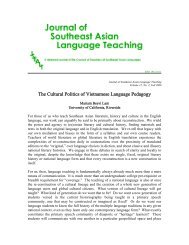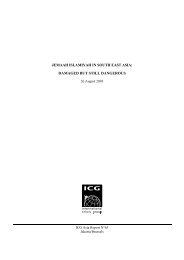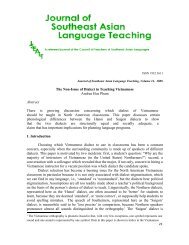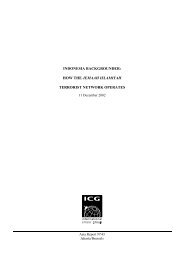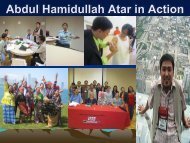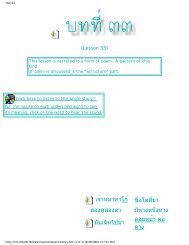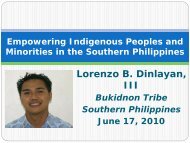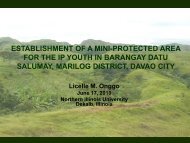Introduction - SEAsite - Northern Illinois University
Introduction - SEAsite - Northern Illinois University
Introduction - SEAsite - Northern Illinois University
Create successful ePaper yourself
Turn your PDF publications into a flip-book with our unique Google optimized e-Paper software.
Prentation Abstracts<br />
and Etic strategies the analysis of this paper derives the contextual and negotiated<br />
meanings and interpretations among the Filipinos’ work experience in Laos. This<br />
conceptualization brings out the interconnections of cultural experiences between<br />
separate, discrete, yet similar groups of people.<br />
The analysis of fifty narratives told by personnel from Operation Brotherhood<br />
(OB), Eastern Construction Company Operations in Laos (ECCOIL), United<br />
States Agency for International Development (USAID), and Air Continental reveal<br />
regional differences among Filipinos and cultural differences between Filipinos<br />
and Laotians, yet an underlying richness of common life experience strengthened<br />
the complicated nexus.<br />
Very few people realize that the Filipinos’ intercultural contact and exchange<br />
with the Laotian people brought about a particularity among the Lao villagers<br />
who they served. The Laotians defined the Filipinos as “thanmos” or doctors who<br />
treated patients on their Mobile Clinic boat that plied the Mekong River. In other<br />
words, all Filipinos were seen as medical doctors. Storytellers indicated how the<br />
Lao experience changed them.<br />
This transformative power of the Philippine-Lao nexus is fully developed in<br />
this paper using the personal untold stories. The stories are anthologized under the<br />
title Goodbye Vientiane: The Untold Stories of Filipinos in Laos, published by the<br />
Philippine AmericanWriters and Artists and will be available at the conference.<br />
Anne Frank<br />
SEAAdoc: Documenting the Southeast Asian American Experience<br />
Irvine Libraries Southeast Asian Archive, <strong>University</strong> of California, California<br />
This presentation will introduce the web portal on Southeast Asian Americans<br />
created by the <strong>University</strong> of California, Irvine Libraries Southeast Asian<br />
Archive. This digitalization project was funded by a generous grant from the National<br />
Endowment for the Humanities (2003-2005).<br />
SEAAdoc: Documenting the Southeast Asian American Experience web<br />
portal is an educational web site that focuses on the cultural, economic, educational,<br />
political, and social experiences of refugees and immigrants from Cambodia,<br />
Laos, and Vietnam. Its objective is to present a sampling of historical and contemporary<br />
primary and secondary materials about the diverse Southeast Asian populations<br />
in the United States, which can be used by students, educators, researchers,<br />
and the general public for research and teaching purposes. The documents in this<br />
project are from the collections housed in the Southeast Asian Archive, unit of the<br />
Department of Special Collections and Archives at Langson Library located at the<br />
<strong>University</strong> of California, Irvine.<br />
This presentation will focus on SEAAdoc’s resources on Laotian Americans, including<br />
ethnic Lao, Hmong, Iu Mien, Khmu, and Lahu.<br />
J. Pete Fuentecilla<br />
Lessons of Refugee Survival<br />
Mekong Circle International, New York, NY<br />
When the Pathet Lao won control of Laos in 1975, waves of lowland Lao and<br />
Hmong, uncertain and fearful of their future under the new rulers, fled the country.<br />
It is estimated that 10 percent of the inhabitants, or some 350,000, settled in<br />
Thailand, the USA, Canada, Australia, France, and other countries. The migration<br />
lasted over 10 years.<br />
The first wave was composed of the elite -- former government and military<br />
personnel and merchants. Among the first wave were Lao lowland nurses, the<br />
products of the first private school of nursing operated by a non-governmental<br />
organization managing a health care program in the country. The author was an<br />
instructor in that school. These nurses represented a sector of a small population of<br />
Lao possessing skills of value and middle-level education. As such they composed<br />
a distinct segment of the refugees, a majority of whom were uneducated Lao farmers<br />
and Hmong tribes people.<br />
This paper will describe the circumstance of their migration to and settlement<br />
in the USA. Their experience will be compared with demographically similar<br />
and dissimilar refugees in the USA, not only from Laos but also from Vietnam<br />
and Cambodia. (All three countries saw the forced migration of large numbers of<br />
their inhabitants during the same period).<br />
Charlotte Gyllenhaal*, Boun Hoong Southavong**, Mary Riley*,<br />
Kongmany Sydara**, Somsanith Bouamanivong**, Amey<br />
Libman*, Djaja Djendoel Soejarto* listed but Riley only<br />
Traditional Medicine Stations: A Design to Study and<br />
Popularize Lao Traditional Medicines, <strong>Illinois</strong><br />
*Program for Collaborative Research in the Pharmaceutical Sciences (PCRPS),<br />
College of Pharmacy, <strong>University</strong> of <strong>Illinois</strong> at Chicago, 833 S. Wood St., Chicago,<br />
IL 60612<br />
**Traditional Medicine Research Center, Ministry of Health, Vientiane, Lao<br />
People’s Democratic Republic<br />
Recognizing the important role of traditional medicine in Laos, the Ministry<br />
of Health established the Traditional Medicine Research Center (TMRC), the only<br />
institute of its kind in Laos. TMRC is charged with the responsibility of conducting<br />
adaptive research on medicinal plants and Traditional Lao Medicine. The Ministry<br />
of Health through TMRC established a network of 10 provincial Traditional<br />
Medicine Stations (TMSs) across Laos. TMSs consist of one or more buildings<br />
with a staff of three to five, whose Heads include university graduates, a Faculty<br />
of Pharmacy graduate, or graduate of secondary medical technical schools. Other<br />
staff members include senior traditional healers and Buddhist monks at some stations.<br />
TMRC staff together with TMS personnel carry out research to inventory<br />
and document traditional medicinal uses of plants, review potential toxic effects<br />
of plants used in traditional medicinal preparations, formulate herbal medicinal<br />
preparations, and educate healers and local communities on sustainable uses of<br />
medicinal plants. Details of research by TMRC and TMSs will be presented. This<br />
project was funded by NIH Grant 1-U01-TW010-50, with support from NIH,<br />
NSF, and USDA FAS.<br />
Rebecca Hall<br />
Tai Banners: Buddhist Import or Adaptation?<br />
Ph.D. candidate, <strong>University</strong> of California, Los Angeles, California<br />
My presentation is a preliminary examination of Tai banners in an attempt<br />
to understand their relationship to the larger world of banners in Asia, with specific<br />
attention paid to banners associated with the practice of Buddhism. The high<br />
value of cloth in pre-modern times likely played an important role in the function<br />
of banners as religious objects; as a result different forms of banners have been<br />
documented throughout Buddhist Asia, from the Indian subcontinent to Japan.<br />
However, Tai banners are markedly different from other Buddhist banners, in construction,<br />
appearance, and function. The motifs on banners make reference to both<br />
Buddhist and Tai cultural motifs present on other textile forms. Thus, a central<br />
concern in this study is whether an existing textile was adapted for use within<br />
the Tai Buddhist temple, or if a new textile form may have been introduced and<br />
adapted for local purposes. In part, then, my presentation on banners is an iconographical<br />
study that will examine physical characteristics and attempt to place<br />
these banners into their historical and cultural contexts. I ask what evidence can be<br />
deduced from the banners and their use to understand their incorporation into local<br />
Tai ceremonies. Banners are an essential visual element of Tai Buddhism whose<br />
iconography, production, and use reveal the delicate balance of external and local<br />
ideologies that exists in these cultures.<br />
Joel M. Halpern* and Larry Ashmun**<br />
A Digital View of Laos: The Joel M. Halpern Laotian Slide<br />
Collection, SEAiT, <strong>University</strong> of Wisconsin-Madison<br />
*Professor Emeritus, <strong>University</strong> of Massachusetts at Amherst, Massachusetts<br />
**<strong>University</strong> of Wisconsin-Madison, Madison<br />
Consisting of slightly over 3000 images, the Joel M. Halpern Laotian Slide<br />
Collection is a unique portrait of life in Laos. Nearly all of the images were personally<br />
taken by Professor Halpern, an anthropologist, in Laos in 1957, 1959,<br />
and 1969. He initially went to Laos as a Junior Foreign Service Officer attached<br />
to USOM, the U.S. Operations Mission, in January 1957 and stayed until the end<br />
of the year. Subsequently supported by the Rand Corporation and a <strong>University</strong> of<br />
California Junior Faculty Fellowship, Prof. Halpern returned to Laos in 1959 to<br />
conduct a study of, in particular, the Lao elite. His stays and research resulted in<br />
some of the first American academic work on Laos, a French colony from 1893<br />
to 1953, most notably the 22-volume Laos Project Paper series while at UCLA<br />
in 1961-2. In 1969, Prof. Halpern was back in Laos as a member of the Mekong






